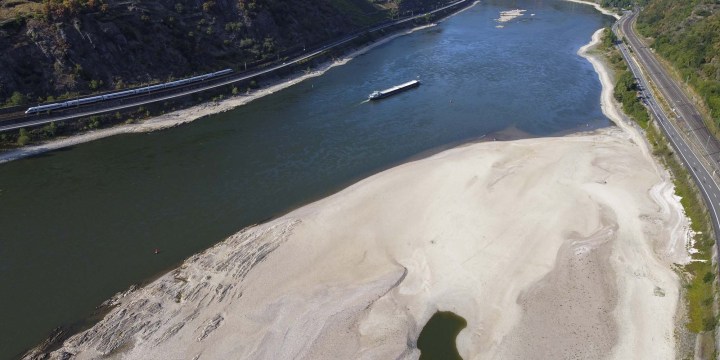CLIMATE ROUND-UP
French activists fill golf course holes with cement in protest at watering exemptions

The climate crisis is being felt and dealt with in various ways worldwide. In these climate shorts, we aim to give a round-up of the latest developments and news from across the globe.
Climate activists affiliated with Extinction Rebellion have targeted golf courses in southern France, filling holes with concrete in protest over exemptions from water restrictions during one of the worst droughts on record.
France has told residents to avoid non-essential water usage such as car-washing and watering gardens. However, activists complain that golf courses are allowed to continue watering greens.
The protest action took place at the Vieille-Toulouse club and also at the Garonne des Sept Deniers course.
Defending their exemption from the water restrictions, Gerard Rougier of the French Golf Federation told the France Info news website: “A golf course without a green is like an ice-rink without ice.”
Extinction Rebellion Toulouse posted a photograph on Twitter apparently showing a golf hole filled with cement and a sign saying, “This hole is drinking 277,000 litres. Do you drink that much? #Stop Golf.”
A petition aimed at scrapping the exemption enjoyed by French golf courses during drought said: “Economic madness takes precedence over ecological reason.”
Water bans are enforced at the discretion of regional officials and so far only Ille-et-Vilaine in western France has banned the watering of golf courses.
France had been one of the hardest hit by the hot and dry conditions across Europe, with firefighters battling a “monster” blaze in forests in southwest France. — Reuters
A desert nation turns to hydroponics to make feed for its livestock
The United Arab Emirates is turning to vertical farming and hydroponics to produce food for local livestock, as the desert nation tries to reduce its reliance on imports and shield itself from disruptions to global supply chains.
Abu Dhabi-based startup World of Farming will begin building on-site operations at local farms later this year to provide fodder for meat and dairy producers that rely on imports for as much as 80% to 90% of their animal feed, said Faris Mesmar, chief executive officer of Hatch & Boost Ventures, a venture capital firm that launches and scales its own startups.
“This region doesn’t have a lot of arable land and the dependency on imports is becoming an issue for all local privately held and commercial farms,” said Mesmar in an interview. Local livestock producers “find themselves with no consistent access with food to feed their animals”.
Land or resource-scarce countries from the Middle East to Asia are increasingly seeking to insulate themselves against food shocks and global supply chain disruptions caused by the pandemic, politics and extreme weather. Russia’s invasion of Ukraine has disrupted supplies from one of the world’s top grain exporters, while heat waves have been wilting crops in Europe and the US.
Techniques such as hydroponics, drip irrigation and enclosed cultivation allow desert nations such as the UAE to reduce costly imports of high-value fresh produce.
Dubai-based airline Emirates opened what it says is the world’s largest hydroponics farm in July to supply leafy greens for in-flight meals. Hydroponic, vertical farms typically grow plants indoors without soil, irrigating the crops with a water-based nutrient solution and often use artificial light.
Still, it’s rare to find the system used to supply animal feed. World of Farming says its technology offers fodder production with a significantly lower carbon footprint than traditional open-land agriculture and requires less water and space. The venture uses artificial intelligence and imagery to monitor the health and growth rate of plants and can optimise output depending on the changing needs of the animals they will feed. — Bloomberg
Much of the US will be an ‘extreme heat belt’ by the 2050s
So you think it’s hot out there now? Consider the summer of 2053. That’s what researchers at First Street Foundation, a New York nonprofit that studies climate risk, have done in a report published on Monday.
They predict that in three decades, more than 100 million Americans will live in an “extreme heat belt” where at least one day a year, the heat index temperature will exceed 52°C — the top level of the National Weather Service’s heat index, or the extreme danger level. (The index combines temperature and humidity to arrive at how it feels when you go outside.)
Along with the report, First Street has released a free web tool that lets users search US addresses to determine their heat risk.
The future heat belt is a huge swathe of the country that includes the southeast and the area just west of the Appalachian Mountains, stretching from Texas and Louisiana all the way up through Missouri and Iowa to the Wisconsin border. This is not the part of the nation we most associate with heat, but since it is inland, there are “no coastal influences to mitigate extreme temperatures”, and many communities “are not acclimated to warmer weather relative to their normal climate”, the report states.
The sharpest heat increase, however, will be felt in Miami-Dade County, Florida, where the hottest days now, those reaching 39.4°C, will increase in frequency from seven days a year to 34 by 2053.
The findings are part of the sixth report by First Street to help Americans picture how warming will impact them at home. Previous reports looked at fire and floods, and the foundation made available fire and flood risk scores for every property in the contiguous US on its website.
According to the report, across the country, on average, peak temperatures now on the hottest seven days per year will reach 18 days a year in most localities. — Bloomberg
Rhine to recede further as climate crisis adds to energy crunch
The Rhine River is set to continue shrivelling early into next week, further restricting the supply of vital commodities to parts of inland Europe as the continent battles with its worst energy crisis in decades.
A key water marker at Kaub — where the river is narrow and shallow — is poised to fall to 30cm by Monday and drop further in subsequent days, according to German government data. At 40cm, a level it reached Friday, it’s not economical for many barges to transit the chokepoint.
The Rhine is used to ship everything from fuels to chemicals, paper products to grains. The climate crisis couldn’t happen at a worse time, with Europe already in the grip of an energy supply crunch worsened by Russia’s war in Ukraine. As climate change dries up Europe’s rivers, it’s only worsening the cost-of-living crisis.
Companies have been taking steps to prepare for the disruption to shipping services, turning to rail and road to transport goods.
The river crisis is especially concerning for landlocked countries in central and eastern Europe that normally get fuel via the Rhine, according to the International Energy Agency.
“We’re expecting this situation to continue towards the end of the year,” Toril Bosoni, head of the IEA’s oil market division, said in a Bloomberg Television interview on Thursday. — Bloomberg
China’s Yangtze river shrinks as heat wave, drought threaten crops
Regions that rely on the Yangtze, China’s longest river, are having to deploy pumps and cloud-seeding rockets as a long drought depletes water levels and threatens crops, and a heat wave is set to last another two weeks.
The Yangtze’s middle and lower reaches have faced temperatures in excess of 40°C over the past month, with experts blaming climate change-induced variations in the western Pacific subtropical high, a major determinant of summer weather throughout east Asia.
With the autumn harvest under threat, the agriculture ministry has deployed 25 teams to key regions to take action to protect crops, the Shanghai government’s Guangming Daily newspaper reported.
The heat wave is likely to last for another two weeks, making it the longest sustained period of extreme temperatures since records began in 1961, experts with China’s National Climate Centre told the official Science and Technology Daily on Monday.
Rainfall in the Yangtze drainage area fell about 30% in July and is 60% lower than normal in August, with the river’s tributaries “significantly lower” than historical levels, according to the Yangtze River Water Resources Commission.
The Poyang lake in central China’s Jiangxi province, which plays a major role in regulating Yangtze water flows in the summer, has shrunk to levels normally seen during the winter dry season after a 50% decline in rain in July.
Villages relying on water from the lake have been forced to deploy pumps to irrigate rice fields, media reported.
In the sprawling southwestern municipality of Chongqing, facing its second-hottest summer since records began in 1961, 900 missiles have been made available to try to “seed” clouds and induce rain, media reported.
Other regions have launched their own weather modification operations.
China normally releases water from the Three Gorges reservoir to relieve drought on the Yangtze, but downstream outflows are half the level of a year earlier, official data showed. — Reuters



















 Become an Insider
Become an Insider
Comments - Please login in order to comment.